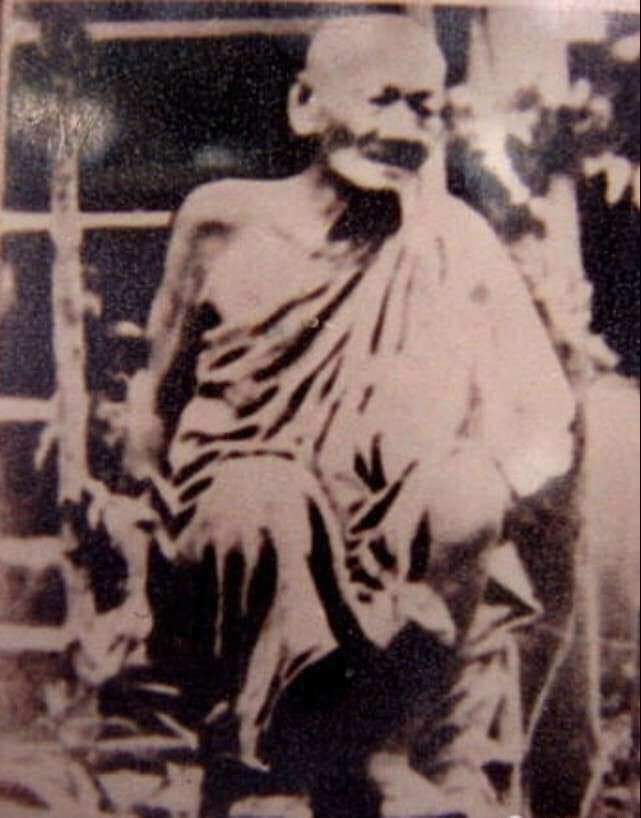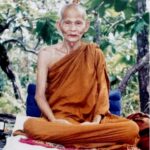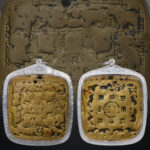
13 Jan 𝐋𝐮𝐚𝐧𝐠 𝐏𝐮 𝐓𝐡𝐨𝐧𝐠 𝐨𝐟 𝐖𝐚𝐭 𝐑𝐚𝐭𝐜𝐡𝐚𝐲𝐨𝐭𝐡𝐚 (𝐖𝐚𝐭 𝐋𝐚𝐝 𝐁𝐮𝐚 𝐊𝐡𝐚𝐨), 𝐁𝐚𝐧𝐠𝐤𝐨𝐤
Below is the Biography of Lp Thong Wat Rachayotha who was a fellow “classmate” of Prah Somdej Phutthajantho (Arjan Toh) and main Master to Por Tiang the legendary Sakyant Master.
I was introduced to this Master by Arjan Dech whom one of his Masters was Lp Liu Wat Rachayotha (Linage of Lp Thong) till date even though Arjan has passed on for more than 10 years already I still have a piece of paper where he wrote the address of the Temple for me. Till date I have yet to visit but will do so and make merits (Sankatan) for Arjan.
Besides Arjan Dech, Arjan Piak, Arjan Chai, Arjan Tong all whom are top Sakyant Masters have the same Bucha as the one Arjan Dech passed to me. Arjan Piak was from the lineage of Lp Saweng Wat Sawangpod whom is a luksit of Lp Jong Wat Natangnok friends with Lp Thong.
Recent years I’ve seen all kinds of new dealers all selling junk items with 0 religious/spiritual/historical significance those who buy them really got no fate/baramee to even own a basic amulet. If you’re reading this post it’s your fate we have met do continue to follow, you’ll definitely get a nice piece that suits you and speaks to your heart.
Lp Thong is one such Master that is worth knowing/researching about.
𝐋𝐮𝐚𝐧𝐠 𝐏𝐮 𝐓𝐡𝐨𝐧𝐠 𝐨𝐟 𝐖𝐚𝐭 𝐑𝐚𝐭𝐜𝐡𝐚𝐲𝐨𝐭𝐡𝐚 (𝐖𝐚𝐭 𝐋𝐚𝐝 𝐁𝐮𝐚 𝐊𝐡𝐚𝐨), 𝐁𝐚𝐧𝐠𝐤𝐨𝐤
Luang Pu Thong Ayana was born in 1820 (B.E. 2363) during the late reign of King Rama II. He was the son of Mr. Huad Sae Lim, a Hokkiens Chinese immigrant, and his Mon (Burmese ethnic) wife.
Luang Pu Thong was ordained as a monk in 1841 (B.E. 2384) at Wat Ngern Bang Phrom, Taling Chan, under the mentorship of Chao Khun Winai Kittajaree Thera (Phu), the second abbot of Wat Ngern Bang Phrom, who served as his preceptor. Upon ordination, he was given the monastic name Ayana in Pali.
Following his ordination, Luang Pu Thong resided at Wat Ngern Bang Phrom, where he devoted himself to studying Dhamma-Vinaya (Buddhist teachings and monastic discipline) while attending to his preceptor.
He later embarked on ascetic wanderings in search of enlightenment. When the construction of Wat Ratchayotha was completed, Luang Pu Thong was invited to become the temple’s first abbot.
Luang Pu Thong was a highly revered and skilled Buddhist monk of his time, often regarded as one of the foremost spiritual masters.
𝐇𝐞 𝐰𝐚𝐬 𝐚 𝐣𝐮𝐧𝐢𝐨𝐫 𝐜𝐨𝐧𝐭𝐞𝐦𝐩𝐨𝐫𝐚𝐫𝐲 𝐨𝐟 𝐭𝐡𝐞 𝐥𝐞𝐠𝐞𝐧𝐝𝐚𝐫𝐲 𝐒𝐨𝐦𝐝𝐞𝐭 𝐏𝐡𝐫𝐚 𝐏𝐡𝐮𝐭𝐭𝐡𝐚𝐜𝐡𝐚𝐧 (𝐓𝐨 𝐏𝐡𝐫𝐨𝐦𝐦𝐚𝐫𝐚𝐧𝐠𝐬𝐢) 𝐚𝐧𝐝 𝐬𝐡𝐚𝐫𝐞𝐝 𝐚 𝐬𝐢𝐦𝐢𝐥𝐚𝐫 𝐭𝐞𝐚𝐜𝐡𝐞𝐫, 𝐋𝐮𝐚𝐧𝐠 𝐏𝐮 𝐒𝐚𝐞𝐧𝐠 𝐨𝐟 𝐖𝐚𝐭 𝐌𝐚𝐧𝐢 𝐂𝐡𝐨𝐧 𝐊𝐡𝐮𝐧, 𝐋𝐨𝐩𝐛𝐮𝐫𝐢. 𝐎𝐭𝐡𝐞𝐫 𝐧𝐨𝐭𝐚𝐛𝐥𝐞 𝐜𝐨𝐧𝐭𝐞𝐦𝐩𝐨𝐫𝐚𝐫𝐢𝐞𝐬 𝐢𝐧𝐜𝐥𝐮𝐝𝐞𝐝 𝐋𝐮𝐚𝐧𝐠 𝐏𝐮 𝐊𝐚𝐞𝐰 𝐨𝐟 𝐖𝐚𝐭 𝐊𝐡𝐫𝐮𝐞𝐚 𝐖𝐚𝐧.
Close Companions and Associates
Luang Pu Thong frequently exchanged knowledge and spiritual practices with other highly regarded monks of his era, such as:
𝐋𝐮𝐚𝐧𝐠 𝐏𝐡𝐨 𝐍𝐠𝐨𝐞𝐧, 𝐖𝐚𝐭 𝐁𝐚𝐧𝐠 𝐊𝐡𝐥𝐚𝐧, 𝐏𝐡𝐢𝐜𝐡𝐢𝐭 𝐏𝐫𝐨𝐯𝐢𝐧𝐜𝐞
𝐋𝐮𝐚𝐧𝐠 𝐏𝐮 𝐒𝐮𝐤, 𝐖𝐚𝐭 𝐌𝐚𝐤𝐡𝐚𝐦 𝐓𝐡𝐚𝐨, 𝐂𝐡𝐚𝐢𝐧𝐚𝐭 𝐏𝐫𝐨𝐯𝐢𝐧𝐜𝐞
𝐋𝐮𝐚𝐧𝐠 𝐏𝐮 𝐏𝐡𝐫𝐢𝐧𝐠, 𝐖𝐚𝐭 𝐁𝐚𝐧𝐠 𝐏𝐚𝐤𝐨𝐤
𝐋𝐮𝐚𝐧𝐠 𝐏𝐮 𝐏𝐡𝐮, 𝐖𝐚𝐭 𝐈𝐧𝐭𝐡𝐚𝐫𝐚𝐦
𝐋𝐮𝐚𝐧𝐠 𝐏𝐮 𝐈𝐚𝐦, 𝐖𝐚𝐭 𝐍𝐚𝐧𝐠
𝐋𝐮𝐚𝐧𝐠 𝐏𝐮 𝐂𝐡𝐚𝐞𝐦, 𝐖𝐚𝐭 𝐂𝐡𝐚𝐥𝐨𝐧𝐠, 𝐏𝐡𝐮𝐤𝐞𝐭 𝐏𝐫𝐨𝐯𝐢𝐧𝐜𝐞
𝐂𝐡𝐚𝐨 𝐊𝐡𝐮𝐧 𝐌𝐚, 𝐖𝐚𝐭 𝐒𝐚𝐦 𝐏𝐥𝐮𝐞𝐦
𝐋𝐮𝐚𝐧𝐠 𝐏𝐮 𝐏𝐚𝐧, 𝐖𝐚𝐭 𝐍𝐠𝐞𝐫𝐧, 𝐓𝐚𝐥𝐢𝐧𝐠 𝐂𝐡𝐚𝐧
Notable Disciples
Among his prominent disciples were many renowned monks and lay practitioners, including:
Luang Pu Phueak of Wat King Kaeo, a close disciple who was ordained by Luang Pu Thong himself.
Luang Pu Thong provided sacred powders from Somdet Phra Phutthachan (To), his elder contemporary, to assist in creating sacred amulets.
Luang Pu Luea, Wat Sao Cha Ngok, Chachoengsao Province
Luang Pho Chong, Wat Na Tang Nok, Ayutthaya Province
Luang Pu Khong, Wat Bang Kaphom, Samut Songkhram Province
Luang Pu Chad, Wat Bang Kabeo, Prachinburi Province
Luang Pho Sodh, Wat Paknam Bhasicharoen
Luang Pho Khlai, Wat Suan Khan, Nakhon Si Thammarat Province
Luang Pho Thongyoo, Wat Mai Nong Phra Ong, Samut Sakhon Province
Luang Pho Chaem, Wat Takong, Phuket Province
Luang Pho Yi, Wat Sattahip, Chonburi Province
His lay disciples included notable spiritual practitioners such as Ajahn Kaew Khumwiboon, Ajahn Thiang Nuammanah (from Ban Mee Dee Hermitage), Ajahn Thaew Krodetch, and Ajahn Jek of Sam Yaek Fai Chai Hermitage.
Sacred Amulets and Objects
Luang Pu Thong crafted and blessed a variety of sacred items to support his disciples’ faith and spiritual pursuits. These included:
Chewing Betel Nut Charms
Takrut Charms (Sacred Scrolls)
Hand-Drawn Yantra Cloths and Shirts
Clay and Powder Amulets featuring the Trinisingha Yant (Protective Symbol) and Somdet Phra Phutthachan-style designs.
Meukpatra Amulets (Metallic) created around 1916 (B.E. 2459–2460).
Rare Clay and Metal Amulets including Pidta Yant designs, Lady of Grace designs, and walking Buddha postures, crafted during his later years (1933–1936, B.E. 2476–2479).
Medal Amulets, including the popular “Floating Face” medal (1934, B.E. 2477) and “Sunken Face” medal (1937, B.E. 2480), both highly sought after today.
His amulets gained widespread popularity and are now exceedingly rare, with some examples preserved by collectors, such as the Somdet Green Sticky Amulet and the Somdet Bueng Phrayasuren Amulet, which he blessed.
Role in National Defense
During the Indochina War, Luang Pu Thong was invited by Field Marshal Plaek Phibunsongkhram, one of his disciples and then Prime Minister, to consecrate sacred sand and distribute it around Wat Phra Kaew (the Temple of the Emerald Buddha) and Sanam Luang to protect the area from enemy bombs.
Luang Pu Thong also created sacred yantra shirts for soldiers during the war. These shirts were reputed to grant invincibility, earning Thai soldiers the nickname “Ghost Soldiers” due to their resilience and miraculous survivals. To meet the overwhelming demand, Luang Pu Thong enlisted the help of five other venerable monks, including:
𝐋𝐮𝐚𝐧𝐠 𝐏𝐮 𝐂𝐡𝐚𝐞𝐦, 𝐖𝐚𝐭 𝐓𝐚𝐤𝐨𝐧𝐠
𝐋𝐮𝐚𝐧𝐠 𝐏𝐮 𝐊𝐡𝐨𝐧𝐠, 𝐖𝐚𝐭 𝐁𝐚𝐧𝐠 𝐊𝐚𝐩𝐡𝐨𝐦
𝐋𝐮𝐚𝐧𝐠 𝐏𝐡𝐨 𝐂𝐡𝐨𝐧𝐠, 𝐖𝐚𝐭 𝐍𝐚 𝐓𝐚𝐧𝐠 𝐍𝐨𝐤
𝐋𝐮𝐚𝐧𝐠 𝐏𝐮 𝐂𝐡𝐚𝐝, 𝐖𝐚𝐭 𝐁𝐚𝐧𝐠 𝐊𝐚𝐛𝐞𝐨
𝐋𝐮𝐚𝐧𝐠 𝐏𝐮 𝐏𝐡𝐮𝐞𝐚𝐤, 𝐖𝐚𝐭 𝐊𝐢𝐧𝐠 𝐊𝐚𝐞𝐨
Mystical Powers and Legacy
Luang Pu Thong was renowned for his supernatural abilities and miraculous deeds. It was said that even photographs of him were difficult to take, as they would often fail to capture his image clearly. The most well-known photograph of Luang Pu Thong, taken at the behest of his disciples, shows him descending the temple stairs for his meal.
Luang Pu Thong passed away in 1937 (B.E. 2480) at the age of 117 years, leaving behind a legacy as one of Thailand’s greatest and most revered Buddhist masters. His teachings, amulets, and stories continue to inspire and guide devotees to this day.






No Comments